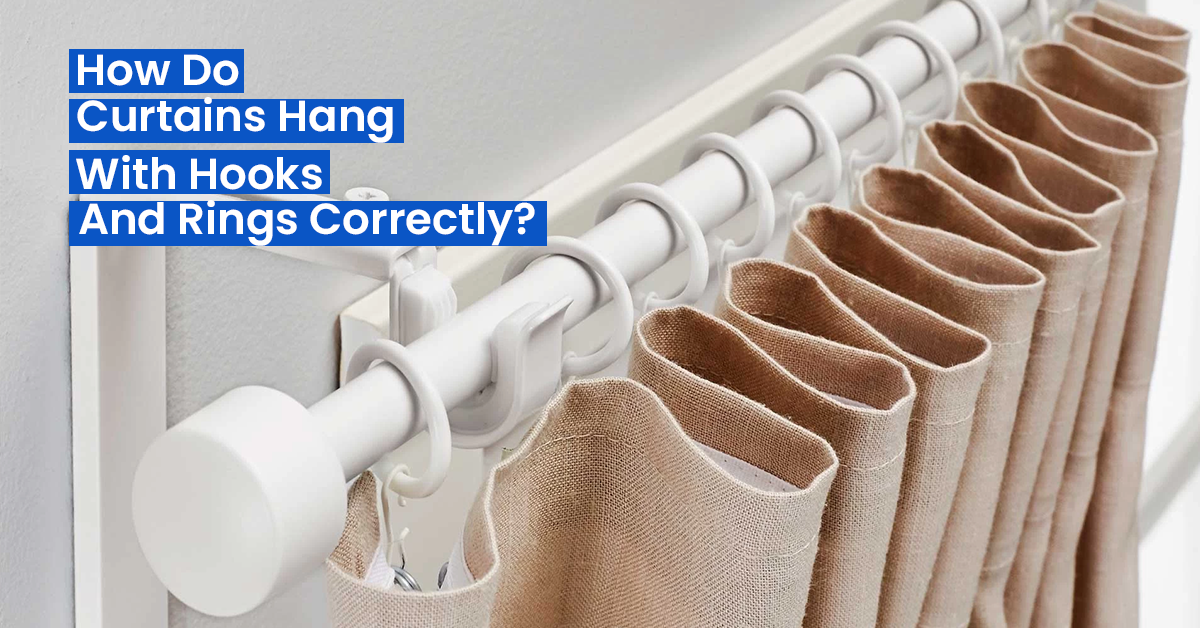Curtains are essential in giving your windows a stylish and useful touch. Hooks and rings are a common and adaptable technique for hanging curtains, among other options. Using this technique makes your window coverings seem better and makes it easier to open and close the curtains. In addition to outlining the advantages of utilising hooks and rings, this tutorial will walk you through the process of correctly hanging curtains.
Benefits of Using Hooks and Rings for Hanging Curtains

Before diving into the installation process, let's understand why many homeowners prefer hooks and rings.
- Versatility: Hooks and rings offer flexibility, allowing you to easily change curtains or update the look of your space without much hassle.
- Smooth Operation: Curtains hung with hooks and rings glide effortlessly, providing a smooth opening and closing experience.
- Enhanced Aesthetics: The decorative aspect of hooks and rings adds a touch of elegance to your window treatments, elevating the room's overall look.
- Easy Maintenance: Cleaning and maintaining curtains become more manageable when using hooks and rings as they can be easily removed for washing.
Now, let's move on to the tools and materials you'll need for this project.
Tools and Materials Needed To Hang Curtains With Hooks And Rings
A. Types of Hooks and Rings

- S-shaped hooks: These are commonly used for lightweight curtains and offer a simple and sleek design.
-
Round rings with clips: Ideal for curtains with pinch pleats, these rings provide a secure grip on the fabric.

-
Decorative hooks and rings: For those looking to add a decorative flair to their curtains, various styles and designs are available to complement different aesthetics.

B. Choosing the Right Size and Material
- Sizing Guide: Select hooks and rings based on the weight and fullness of your curtains. Consider the brushed silver curtain rod diameter when choosing the size.
- Materials Comparison (Metal, Plastic, Wood): Each material has advantages. Metal offers durability, plastic is lightweight, and wood provides a natural and warm aesthetic.
Step 1: Measuring and Marking

A. Proper Curtain Placement
Consider the desired height of your curtains concerning the window and ceiling. Hanging curtains higher can create an illusion of taller windows and a more spacious room.
B. Measuring for Hooks and Rings
- Height Considerations: Measure from the top of the curtain to the desired length, considering the space needed for the rings and hooks.
- Spacing for an Even Look: Plan the spacing of hooks to ensure an even distribution of fabric when the curtains are closed.
Step 2: Preparing the Curtains
A. Determining Curtain Fullness
Decide on the fullness of your curtains based on personal preference and the style of your curtains. Fullness adds volume and creates a luxurious look.
B. Adding Curtain Weights for Better Draping
Consider adding weights to the bottom hem of your curtains to ensure they hang straight and maintain a polished appearance.
Step 3: Installing Wall Hooks

A. Types of Walls and Suitable Anchors
Determine your wall type (drywall, plaster, etc.) and choose appropriate anchors to ensure a secure installation.
B. Step-by-step Installation Guide
- Marking Drill Points: Use a level to mark drill points for the hooks, ensuring they are evenly spaced.
- Using Wall Anchors: Install wall anchors according to the manufacturer's instructions, providing a sturdy foundation for the hooks.
- Securing Hooks in Place: Screw the hooks into the anchors, ensuring they are firmly attached to the wall.
Step 4: Attaching Rings to Curtains

A. Selecting the Right Attachment Method
Choose between sewing rings directly onto the curtain fabric or using clips for a non-permanent option.
B. Sewing vs. Clipping Options
Sewing provides a more seamless and integrated look, while clipping allows for easy removal and interchangeability of curtains.
Step 5: Hanging Curtains with Precision

A. Achieving a Level Alignment
Use a level to ensure the matt black curtain pole is perfectly horizontal, preventing the curtains from hanging unevenly.
B. Ensuring an Even Distribution of Fabric
Slide the rings onto the curtain rod, adjusting the spacing to achieve an even distribution of fabric when the curtains are closed.
Avoid Common Issues
- Curtains Not Hanging Evenly: Double-check measurements and spacing during installation to avoid uneven hanging.
- Hooks Coming Loose - Fixing and Preventing: Tighten hooks periodically and use additional wall anchors if needed.
- Child and Pet Safety Measures: Consider using cordless options or installing safety devices to prevent accidents.
Conclusion
Hanging curtains with hooks and rings is a DIY project that can enhance the aesthetics and functionality of your space. Following the steps outlined in this guide, you can achieve a professional and polished look for your window treatments.
FAQs
Can I use hooks and rings for all types of curtains?
Yes, hooks and rings are versatile and can be used for various curtain styles, including lightweight and heavy curtains.
What do I do if my curtains are too heavy?
Choose sturdy hooks and rings to support heavy curtains, and ensure that your wall anchors are sufficient for the added weight.
Are there any alternatives to wall hooks?
Yes, alternatives include curtain tracks, tension rods, and other specialized curtain hardware. Choose the option that best suits your needs and preferences.


